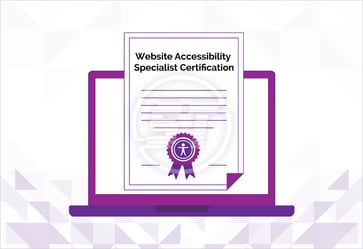The disability is not a problem, but the accessibility is!
From where a person with a disability will get a piece of important information if the content is not accessible to him? How will a disabled user learn modern technologies if the digital content is hard to peruse for such a user?
Digital content influences wide-ranging aspects of our lives. In fact, it is an inseparable part of everyone’s life including people with some sort of disability. Thus, if you have not put content accessibility on your radar yet, you should now. Before your competitors take the advantage of your shortcoming and move ahead from you, start modifying your content.
Also, ask yourself, what is your vision behind creating digital content? You surely want to reach more and more audiences and make your business website, blog, application, digital products, online tools, etc. popular. But it will be disheartening for you when you put your heart and soul into your content, and the analytics show its poor performance on search engines.
Do you know, what can be the primary reason, your content is not performing well on the web? Is it inaccessibility?
It can be. Thus, pay attention to digital content accessibility and improve the accessibility, UX, and search engine performance.
Keep reading this article to know what mistakes you are doing while creating the content.
YOU MAY ALSO LIKE: Global Accessibility Awareness Day
Importance of digital accessibility
Accessibility to digital assets and content can be a boon for people with any sort of disability. They can be able to easily access the products and services available online without any complications.
Research says, 1 out of every 4 citizens in the US has some sort of disability. Can you imagine the number, who cannot access the content available online due to its inaccessibility? And accessibility is not only crucial for users with disabilities, but it is important for every person (with or without any disability), your business and SEO as well.
If your content is accessible, it boosts your business because a significant number of people who have some problem accessing the content will be able to access the content and buy your products and services. Thus, accessibility is beneficial for your ecommerce business.
The WCAG and ADA guidelines help you create accessible content, and also assist in search engine optimization. For example, alt text with images is helpful for blind users, and it also helps search engines to recognize your content. Similarly, headings to make the content comprehensible for screen readers, it also aids search engines to scan the page and understand the content. So, accessibility improves SEO as well.
When you write easy to read content, users with cognitive issues can understand the content easily. Breaking content into small segments with proper headings makes it comprehensive for screen readers and usable for many readers who don’t want to peruse the entire content. In a nutshell, the accessible content is beneficial for every user and ultimately for your business.
The idea behind accessibility is truly clear, provide accessible digital content and scale your business.
Digital content accessibility checklist
The use of HTML elements makes the content accessible
You can either use WYSIWYG editor to edit your content and can see the difference immediately or you have the option to edit HTML elements directly.
HTML elements in your content are the building blocks of the web. That’s why they help browsers to know everything about your content and browsers display the content in the correct way. These HTML elements are used by assistive technologies as well to assimilate the content and help people with disabilities to navigate around the content.
Therefore, using correct HTML elements makes your content accessible and useful to everyone.
Proper and smooth navigation matters
Content accessibility refers that people can access the content on your web page. What if a user starts exploring your web page and cannot find the content, he is looking for? Therefore, you should focus on navigation carefully; on-page navigation and switching between sections must be smooth. Furthermore, the progress bar should indicate clearly, where the user on your page is.
Try some tips to optimize navigation
- Include site search with navigation menus and ensure the site search results the relevant pages with correct title and summary.
- Update and maintain all links on the page for desired navigation. Furthermore, maintain the header & footer links and sitemap as well, they are essential for uninterrupted navigation.
- Always use a meaningful link and button on a web page.
Moreover, Find these UX design accessibility best practices to achieve successful ADA compliance!
Structured content for accessibility
The structured data and content help users to understand it thoroughly and makes it easier for assistive technologies to translate it correctly for the people who use such technologies.
You can curate structured content by,
- Using correct heading hierarchy. Every page has one main H1 heading followed by H2 sub-heading then H3, H4, and so on.
- Use the list to present important points, instructions, etc. It assists screen readers to understand the content and swiftly find the important information.
Accessibility requires readable content
Write easy-to-read and understand content.
- Avoid using jargon and if using technical terms and acronyms, explain them.
- Try to include easy to read sentences.
- Check the color contrast between text and background to make it easily readable.
- Don’t use stylish texts (such as italic, comic sans, etc.) that are hard to read. Moreover, ensure you have set the text size to 12 points or 16 pixels (which is a standard size of readable text).
- Text spacing is also critical to check.
Convey the content meaning clearly
Every word in your web page content must have a clear meaning. If you are using colors on the page to denote something, add associated text to explain the meaning of color. Let’s say, you have inserted a chart in between the content, and it has a color differentiator for varied factors. The screen readers will not understand the colors and what they are denoting. Therefore, you must add clear text with colors to make them comprehensible for everyone.
Focus on images' accessibility
Try not to use too many images in-between content, and wherever images are, make sure to use alt text with them. If images are only to enhance the beauty of the page, the alt text should be 'null' (<img alt="">), thereby screen readers will ignore them. And if the images are important and providing some important information, alt text must be concise for clear understanding.
Use appropriate text for image alt text to provide correct information to every user.
Tables and multimedia must be accessible
- Make sure all the videos on the page should have a transcript for better accessibility. If you are using automated captioning, edit the captions for more accuracy.
- Tables should have semantic HTML elements, which have meanings and users can navigate them. Also, use the table header, footer, and caption to make it comprehensible.
- Follow accessibility criteria for downloadable files as well.
Make sure to publish accessible content on social media also
Social media is critical for every business these days to promote your content and brands. Therefore, you must publish accessible content on social media, so that every user can access it.
Words with hashtags have no space and use the capital letter before every new word. For example, #uxforall should be written as #UXForAll. Screen readers will easily understand and read the correct form.
Also, enable keyboard navigation for users who use only keyboard to explore the content. And listen to the whole content before making it live to find the errors (if there are some).
All the above pointers are based on WCAG rules to make the content and web accessible. Albeit these guidelines are dense but not hard to comply with. And moreover, as per law, your website is in trouble if you don’t have accessible content.
Ready to create accessible content? Go for it!
Digital content accessibility is not a task, it is a continuous process. It is something that you must work on regularly. World Wide Web is running around content and now our lives are impossible without digital access. We are dependent on digital world for every pint-sized information as well.
Content accessibility implies WCAG and ADA compliant website. If you claim to have a compliant website, then you must have accessible content. Have this handy reference guide to check the composed content every now and then. Create, check, and circulate; apply this rule in a loop. Don’t stress over perfection, instead, focus on progress. There can be small mistakes but with continuous efforts, you will conquer the digital world.
They say, “Content is anything that adds value to a reader’s life.” So, try to add value to your readers’ or users’ life by providing them completely accessible digital content.
Is your website, web application, documents, and mobile application accessible for people with disabilities? With a team of experts, we provide complete ADA web accessibility services including audit, strategy, design, and development services that comply with accessibility regulations such as ADA, WCAG 2.0, 2.1, 2.2 and Section 508 within your budget. Get in touch with us at [email protected] or submit the following request free quote form.


